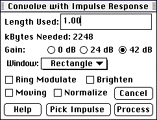 |
SoundHack
seems to work best when the impulse response is relatively short (due
to ram memory).
If the
impulse is too long a message box may appear that declares there is not
enough memory to process. By either increasing the
memory to the program or shortening the 'length used' of the impulse response,
this problem will be alleviated. |